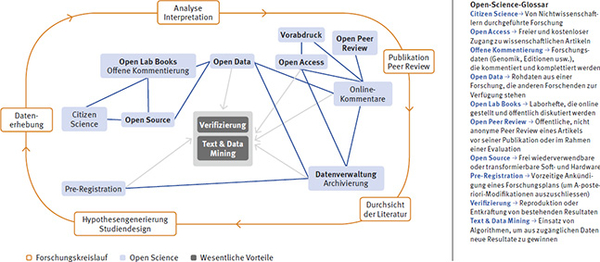Making science more open and transparent
The open science movement wants radical change: science should be made more transparent through cooperation, data sharing and publicly accessible publications.
Year after year, more than a million scientific works are published around the world: publishing activity is increasing exponentially and a reversal of this trend is nowhere in sight. But the knowledge thus accumulated is not always reliable and its accessibility is limited. Many active observers in the world of science, among them the Swiss National Science Foundation, have come to the same conclusion: science needs to become more open, in order to increase its transparency and accessibility, as well as its efficiency. Publications ought to be made available free of charge and without delay (open access) and raw data should be shared, reused and examined (open data). This is a fundamental tenet of “open science”, the new paradigm that aims to redefine scientific activity, from data collection to data analysis, interpretation and publication (see graph “Components of open science”).
The basic idea is to promote scientific exchange and transparency: raw data ought to be published online and made accessible to the public; it ought to be interpreted on blogs and shared platforms and peer reviewed not by a few anonymous experts but by a large number of authors. With regard to the assessment and reuse of research results, it is also key that articles are published in open access mode along with the corresponding raw data. In this way, science will become more credible and more efficient, duplications will largely be eliminated, and research findings will be shared by the community much sooner than they are now.
Changing the system
The principles of open science stand in stark contrast to many established academic incentives: in order to forge a career, researchers are supposed to publish as many articles as possible in highranking journals that are not free of charge. Exchanging research data eats up a lot of time and money as it involves the creation and long-term main tenance of new databases. Another contentious issue concerns the publication of raw data: even researchers who are in favour of open access are worried by the prospect of colleagues criticising their data or using it to publish ahead of them. In addition, sharing data collected with the help of industry partners gives rise to questions about intellectual property rights. “In principle, all researchers are in favour of open science,” says Aysim Yılmaz, open science officer and head of the Biology and Medicine division at the SNSF Administrative Offices. “But it can only be successfully implemented if researchers believe that it will benefit them.”
Despite these difficulties, open science is making headway, thanks mainly to grassroots support for the idea: many researchers are already collaborating online and making their data available in a wide range of disciplines from particle physics to genetics to digital humanities. Others are exploring new ways of communicating, evaluating and publishing. Those involved in setting research agendas also play an important role in the change process, especially funding agencies such as the SNSF, which defines the parameters for research funding. SNSF grantees already need to offer free public access to publications produced in their research projects. In the medium term, the SNSF wants to make freely accessible data and publications the rule rather than the exception. In this context, it will be important to evaluate not only the publications, but also the quality of the data on which they are based.
Changing the culture
Open science is a global movement: the League of European Research Universities (LERU) and the European Union have launched programmes to address open science issues and facilitate implementation. Research funders such as the World Health Organisation (after the Ebola crisis in Africa) and the National Institutes of Health have defined a set of open science criteria. Various funding organisations (e.g. in Norway and the Netherlands) already require open access by default in certain programmes.
A harmonised, universal set of rules should not be the aim, however, as every research area has its own culture and its own challenges. Each must decide by itself what constitutes data and how best to regulate confidentiality issues. Solutions should therefore be developed by each research area, without too much red tape and without generating more work for researchers and institutions. The successful implementation of open science depends on whether the scientific community is able to change its way of thinking, before it hands over to a more open generation that will be instrumental in shaping new forms of collaboration.
Open science glossary
Citizen science -> Research conducted by non-scientists
Open access -> Scientific articles published without paywall
Open annotation-> Research data (genomics, editions, etc.) that can be commented on and completed
Open data -> Unprocessed research results that are made available to other researchers
Open lab books -> Lab books that are published and discussed online
Open peer review -> Non-anonymous and public peer review of an article before publication or before a funding decision
Open source -> Software and hardware that can be freely used and modified
Pre-registration -> Advance announcement of a research plan (to exclude the possibility of changes at a later stage)
Replication -> Reproduction or invalidation of old results
Text & data mining -> Use of algorithms to derive new results from accessible data
